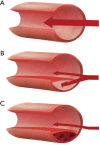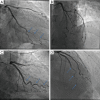Current state-of-play in spontaneous coronary artery dissection
- PMID: 31275818
- PMCID: PMC6603494
- DOI: 10.21037/cdt.2019.04.03
Current state-of-play in spontaneous coronary artery dissection
Abstract
For over 80 years, spontaneous coronary artery dissection (SCAD) has been recognised as a cause of myocardial infarction. SCAD is described as a non-iatrogenic, non-atherosclerotic coronary artery dissection, resulting in formation of a false lumen or intramural haematoma in the coronary artery wall that compresses the true lumen, often compromising myocardial blood flow. In early literature, the incidence of SCAD in acute coronary syndrome (ACS) was underestimated. Recent advances in awareness and widespread early angiographic investigation in ACS has led to important shifts in our understanding of the prevalence, predisposing causes, natural history, aetiology, clinical and angiographic features, management, and prognosis of SCAD. It is now well understood that SCAD predominantly affects women and is responsible for around 20% of ACS presentations in females below the age of 60. Despite this, SCAD is still often overlooked and misdiagnosed as atherosclerotic disease. Misdiagnosis is multifactorial; with contributing factors including a low clinical index of suspicion, particularly in young females, a lack of clinician familiarity with angiographic variants, and limitations of angiography. Although increasing evidence suggests that optimal management is distinct from atherosclerotic coronary artery disease, many questions remain unanswered regarding the pathogenesis and optimal treatment of SCAD, heralding prospective research to answer these questions. This review aims to give a current clinical perspective on SCAD and highlight the importance of familiarity and vigilance with this condition when diagnosing and treating ACS.
Keywords: Acute coronary syndrome (ACS); myocardial infarction; non-atherosclerotic coronary artery disease; spontaneous coronary artery dissection (SCAD).
Conflict of interest statement
Conflicts of Interest: The authors have no conflicts of interest to declare.
Figures






References
-
- Pretty HC. Dissecting aneurysm of coronary artery in a woman aged 42: rupture. Br Med J 1931;1:667.
Publication types
LinkOut - more resources
Full Text Sources
